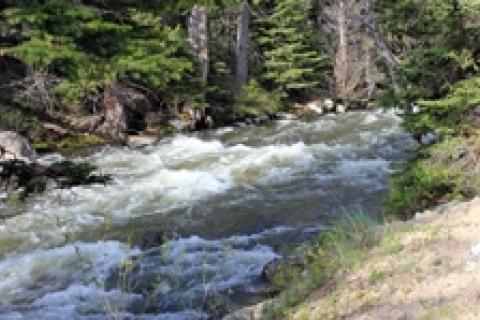
As your favorite rivers or streams start to clear after the spring runoff anglers have the chance to investigate what critters fish are going to be feeding on in the upcoming months. Sampling the aquatic invertebrates found in your area is a fun and educational way to becoming a better fly angler.
 |
| In a healthy stream reach there can be hundreds of individual aquatic invertebrates living in a single square meter of stream bottom. |
Aquatic invertebrates are small animals, such as insects, crustaceans, mollusks, and worms that live in your local rivers, lakes and streams. Most aquatic invertebrates are found living on or near the bottom hidden among the rocks and bottom structure. The insects that we see commonly out of the water like mosquitoes, damselflies, and mayflies all begin their life cycle in water but develop to spend the remainder of their adult lives away from where they were born.
Even to the sharpest of eyes, most stream bottoms appear to be just sand, sticks or rocks. In a healthy stream reach there can be hundreds of individual aquatic invertebrates living in a single square meter of stream bottom.
To sample this enormous variety of aquatic invertebrate life, anglers can rely on a very simple technique (dip/kick netting). It is important to note that although it is relatively easy to trap a large number of aquatic invertebrates in a short period of time the effort to sort and identify your catch is not as simple.
The dip/kick net is a device that has a mesh strip attached to a rectangular or triangular frame (with or without a handle). In the stream, the net is placed on the stream bed and the bottom directly upstream is disturbed, causing organisms to flow into the net. In areas of low water flow, the dip-net is worked through the water roughly (preferably through vegetation) to capture these organisms.
Once you have your aquatic invertebrates place them in a jar with a little fresh water. When you get to tying area take a closer look at what you caught and try to identify and separate the organisms into small groups. The use of online resources or published aquatic invertebrate guides can make this a more straight forward process. You don't have to know the genus and species for each individual invertebrate you caught but a rough idea of what it is will help you to know what will be hatching when and what you should be using while fishing.
Take a good look at the invertebrates you have caught. Note their respected sizes and distinctive colors. These characteristics will be very helpful as you start to tie patterns. Try and get the hook sizes as close as possible to the real thing. Be creative with your dubbing (mix dubbing fibers) or materials (colored by markers) to get the colors to match. When fish begin feeding on a particular type of aquatic invertebrate they can become very selective.
Another important point to think about is to be conscious of what the invertebrates are doing in the jar of water. Are they spread out, curled up, swimming or floating? These observations will help you to choose what types of materials to use when tying, and how spare or dense to make a fly.
Don't get caught trying to guess what fish are feeding on the subsurface. Take the time to sample a few of your favorite bodies and water and see what is really living there. Knowing that these organisms look like and there sizes will help you tie more realistic looking flies that will hopefully end up hooking into more fish.
- 2624 views

